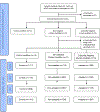Designed Cultural Adaptation and Delivery Quality in Rural Substance Use Prevention: an Effectiveness Trial for the Keepin' it REAL Curriculum
- PMID: 30056616
- PMCID: PMC6202132
- DOI: 10.1007/s11121-018-0937-y
Designed Cultural Adaptation and Delivery Quality in Rural Substance Use Prevention: an Effectiveness Trial for the Keepin' it REAL Curriculum
Abstract
This study examined how cultural adaptation and delivery quality of the school-based intervention keepin' it REAL (kiR) influenced adolescent substance use. The goal of the study was to compare the effectiveness of the multi-cultural, urban (non-adapted) kiR intervention, a re-grounded (adapted) rural version of the kiR intervention and control condition in a new, rural setting. A total of 39 middle schools in rural communities of two states in the USA were randomly assigned to one of three conditions (i.e., control, non-adapted urban kiR, and adapted rural kiR). Data included adolescent self-reported lifetime substance use and observers' ratings of delivery quality from video recordings of lessons. Ratings of delivery quality were used to create four comparison groups (i.e., low/high delivery quality in non-adapted/urban kiR condition and low/high quality in adapted/rural kiR condition). Controlling for substance use in the 7th grade, findings compared 9th graders' (N = 2781) lifetime alcohol, cigarette, marijuana, and chewing tobacco use. Mixed model analyses revealed that rural youth receiving the culturally adapted/rural curriculum reported significantly less cigarette use than rural youth in the control condition regardless of delivery quality. In the non-adapted/urban condition, youth receiving high delivery quality delivery reported less marijuana use than those receiving low delivery quality condition. However, substance use outcomes of youth receiving high and low delivery quality in the non-adapted intervention did not differ significantly from those the control group. Findings support the effectiveness of the culturally adapted/rural keepin' it REAL curriculum for rural youth.
Keywords: Adolescents; Cultural adaptation; Implementation quality; School-based intervention; Substance use.
Conflict of interest statement
Figures
Similar articles
-
Substance Use Prevention for Urban American Indian Youth: A Efficacy Trial of the Culturally Adapted Living in 2 Worlds Program.J Prim Prev. 2017 Apr;38(1-2):137-158. doi: 10.1007/s10935-016-0461-4. J Prim Prev. 2017. PMID: 27943031 Free PMC article. Clinical Trial.
-
Effects of the 5th and 7th grade enhanced versions of the keepin' it REAL substance use prevention curriculum.J Drug Educ. 2010;40(1):61-79. doi: 10.2190/DE.40.1.e. J Drug Educ. 2010. PMID: 21038764 Clinical Trial.
-
Entertainment-Education Videos as a Persuasive Tool in the Substance Use Prevention Intervention "keepin' it REAL".Health Commun. 2018 Jul;33(7):896-906. doi: 10.1080/10410236.2017.1321163. Epub 2017 Jun 6. Health Commun. 2018. PMID: 28586239 Free PMC article.
-
Adapting school-based substance use prevention curriculum through cultural grounding: a review and exemplar of adaptation processes for rural schools.Am J Community Psychol. 2013 Mar;51(1-2):190-205. doi: 10.1007/s10464-012-9524-8. Am J Community Psychol. 2013. PMID: 22961604 Free PMC article. Review.
-
A systematic review of the effect of the school-based drug prevention program Keepin' it REAL: translated and implemented in Brazil by PROERD.Cien Saude Colet. 2022 Nov;27(11):4175-4189. doi: 10.1590/1413-812320222711.07162022. Epub 2022 Jul 3. Cien Saude Colet. 2022. PMID: 36259838 English, Portuguese.
Cited by
-
Short-Term Secondary Effects of a School-Based Drug Prevention Program: Cluster-Randomized Controlled Trial of the Brazilian Version of DARE's Keepin' it REAL.Prev Sci. 2022 Jan;23(1):10-23. doi: 10.1007/s11121-021-01277-w. Epub 2021 Jul 5. Prev Sci. 2022. PMID: 34226985 Clinical Trial.
-
Reasons for alcohol use and non-use by underage U.S. autistic youth: A qualitative study.Autism. 2023 Jan;27(1):213-225. doi: 10.1177/13623613221091319. Epub 2022 May 2. Autism. 2023. PMID: 35499489 Free PMC article.
-
Does Narrative Quality Matter During Implementation of a School-Based Prevention Intervention? A Test of Narrative Engagement Theory.J Health Commun. 2023 Aug 3;28(8):526-538. doi: 10.1080/10810730.2023.2231886. Epub 2023 Jul 3. J Health Commun. 2023. PMID: 37401175 Free PMC article.
-
A Multilevel Latent Class Analysis of Adolescent Engagement in Interpersonal Violence: The Role of Stressful Life Events, School Climate, and School Characteristics.Psychol Violence. 2025 Mar;15(2):192-201. doi: 10.1037/vio0000547. Epub 2024 Sep 26. Psychol Violence. 2025. PMID: 40365137
-
Implementation fidelity of a Brazilian drug use prevention program and its effect among adolescents: a mixed-methods study.Subst Abuse Treat Prev Policy. 2022 Nov 1;17(1):71. doi: 10.1186/s13011-022-00496-w. Subst Abuse Treat Prev Policy. 2022. PMID: 36319981 Free PMC article.
References
-
- Baker TE (2001). Finding the balance: Program fidelity and adaptation in substance abuse prevention: A state-of-the-art review. Center for Substance Abuse Prevention, Substance Abuse and Mental Health Services Administration Retrieved from http://www.eric.ed.gov/PDFS/ED469354.pdf.
-
- Barrera M, Castro FG, & Steiker H (2011). A critical analysis of approaches to the development of preventive interventions for subcultural groups. American Journal of Community Psychology , 48(3–4), 439–454. - PubMed
Publication types
MeSH terms
Grants and funding
LinkOut - more resources
Full Text Sources
Other Literature Sources
Medical


